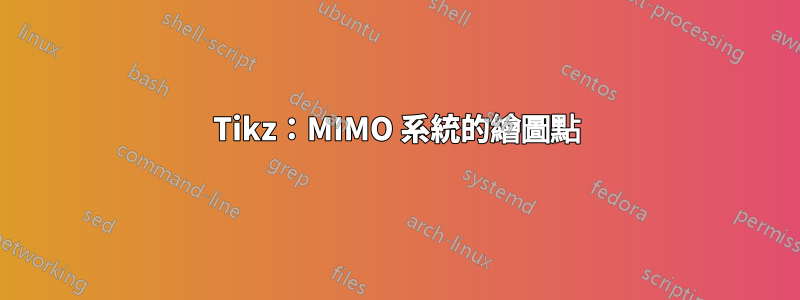
我有以下圖片:
並希望將中間箭頭替換為點,如下圖所示:
\documentclass[12pt,a4paper]{scrartcl}
\begin{document}
\usetikzlibrary{decorations.markings}
\usepackage{tikz}
\begin{figure}[htbp]
\centering
\begin{tikzpicture}
\node (System) [draw,minimum size=24mm] {$\sum$};
\coordinate[above left = of System.west] (a1);
\coordinate[below = of a1] (a2);
\coordinate[below = of a2] (a3);
\coordinate[above right= of System.east] (b1);
\foreach \i [count=\xi from 1] in {2,...,5}
\coordinate[below=of b\xi] (b\i);
\foreach \i [count=\xi from 1] in {$u_1$,$u_2$,$u_3$}
\draw[-latex'] (a\xi) node[left] {\i} -- (a\xi-| System.west);
\foreach \i [count=\xi from 1] in {$y_1$,$y_2$,$y_3$}
\draw[-latex'] (System.east |- b\xi) -- (b\xi) node[right] {\i};
\end{tikzpicture}
\caption{Strukturbild eines MIMO-Systems}
\label{fig:mimo}
\end{figure}
\end{document}
並將最後一個重新命名為yn和un,表示可以有n-in 或outputs。我該如何實現這個目標?
答案1
- 套件和庫必須在文檔序言中載入:第一個包,而不是它的庫!
- 對於您的 MWE,缺少兩個函式庫 (
arrows,positioning) - 我建議不要像下面 MWE 那樣
arrows使用arrows.meta
編輯: 考慮到您下面的評論:
\documentclass[12pt,a4paper]{scrartcl}
\usepackage{tikz}
\usetikzlibrary{arrows.meta,
positioning}
\begin{document}
\begin{figure}[htbp]
\centering
\begin{tikzpicture}[
node distance = 6mm and 12mm
]
\node (System) [draw,minimum size=24mm] {$\sum$};
%
\coordinate[above left = of System.west, label=left:$u_1$] (a1);
\coordinate[ left = of System.west, label=left:$u_2$] (a2);
\coordinate[below left = of System.west, label=left:$u_3$] (a3);
%
\coordinate[above right = of System.east, label=right:$y_1$] (b1);
\coordinate[ right = of System.east, label={[xshift=-4mm]left:$\vdots$}] (b2);
\coordinate[below right = of System.east, label=right:$y_n$] (b3);
%
\foreach \i in {1,2,3}
\draw[-Latex] (a\i) -- (a\i-| System.west);
\foreach \i in {1,3}
\draw[-Latex] (b\i -| System.east) -- (b\i);
\end{tikzpicture}
\caption{Strukturbild eines MIMO-Systems}
\label{fig:mimo}
\end{figure}
\end{document}
上面的 MWE 現在給出:
答案2
人們可以使用該庫添加小圓圈calc:
\documentclass[12pt,a4paper]{scrartcl}
\usepackage{tikz}
\usetikzlibrary{decorations.markings,positioning,arrows,calc}
\begin{document}
\begin{figure}[htbp]
\centering
\begin{tikzpicture}
\node (System) [draw,minimum size=24mm] {$\sum$};
\coordinate[above left = of System.west] (a1);
\coordinate[below = of a1] (a2);
\coordinate[below = of a2] (a3);
\coordinate[above right= of System.east] (b1);
\foreach \i [count=\xi from 1] in {2,...,5}
\coordinate[below=of b\xi] (b\i);
\foreach \i [count=\xi from 1] in {$u_1$,$u_2$}
\draw[-latex'] (a\xi) node[left] {\i} -- (a\xi-| System.west);
\draw[-latex'] (a3) node[left] {$u_n$} -- (a3-| System.west);
%\foreach \i [count=\xi from 1] in {$y_1$,$y_2$,$y_3$}
% \draw[-latex'] (System.east |- b\xi) -- (b\xi) node[right] {\i};
\draw[-latex'] (System.east |- b1) -- (b1) node[right] {$y_1$};
\draw[-latex'] (System.east |- b3) -- (b3) node[right] {$y_n$};
\fill ($(b1)+(-0.5,-0.75)$) circle (0.03cm);
\fill ($(b1)+(-0.5,-1)$) circle (0.03cm);
\fill ($(b1)+(-0.5,-1.25)$) circle (0.03cm);
\end{tikzpicture}
\caption{Strukturbild eines MIMO-Systems}
\label{fig:mimo}
\end{figure}
\end{document}






